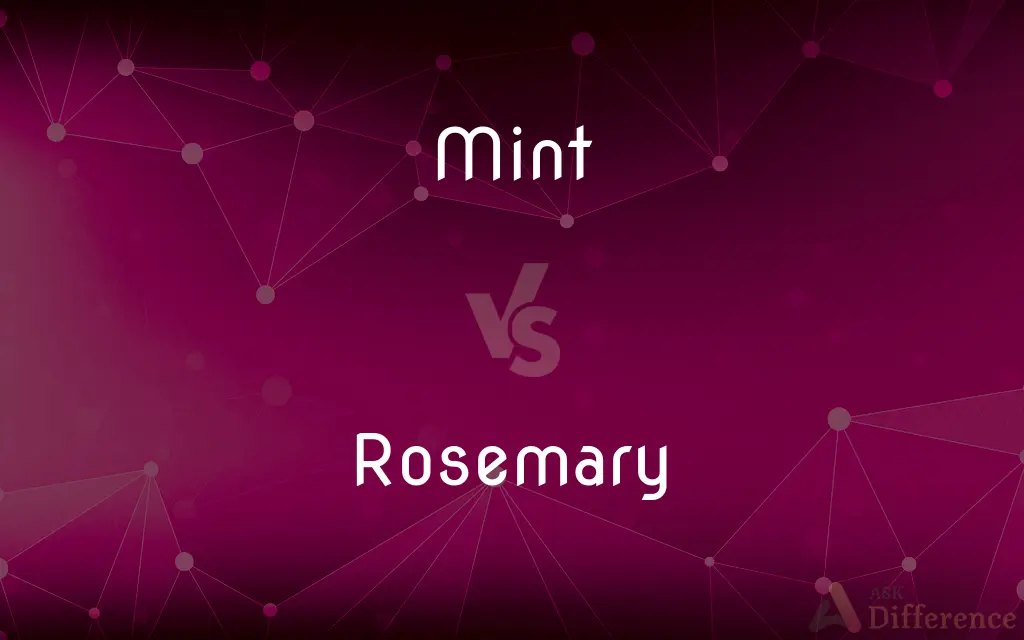Mint vs. Rosemary — What's the Difference?
Edited by Tayyaba Rehman — By Fiza Rafique — Updated on April 16, 2024
Mint is a refreshing herb known for its cool, sweet flavor profile, often used in beverages and desserts, while rosemary is aromatic and woodsy, typically used in savory dishes like meats and breads.

Difference Between Mint and Rosemary
Table of Contents
ADVERTISEMENT
Key Differences
Mint, characterized by its vibrant green leaves and a distinctive cool, sweet flavor, is widely used in both culinary and medicinal applications. In contrast, rosemary, with its needle-like leaves and robust, pine-like aroma, is primarily employed in savory cooking, particularly in Mediterranean cuisine.
While mint leaves are soft and can be eaten raw or lightly cooked, adding a fresh burst of flavor to salads, drinks, and desserts, rosemary's tough, woody texture generally requires it to be cooked, often infused into oils, stews, and roasts to impart its flavor gradually.
Mint thrives in moist environments and spreads rapidly, often considered invasive in gardens. On the other hand, rosemary prefers dry, well-drained soils and grows into a hardy, woody shrub, making it a popular choice in xeriscaping and as an ornamental plant.
Culturally, mint is often associated with freshness and cleanliness, widely used in toothpaste, chewing gums, and teas. Whereas, rosemary is frequently linked to remembrance and has historical uses in wedding ceremonies and medicinal remedies, symbolizing loyalty and health.
In terms of health benefits, mint is noted for its ability to soothe digestive issues and relieve headaches. Rosemary, however, is celebrated for its antioxidant properties and potential to enhance memory and concentration, highlighting its diverse applications beyond the kitchen.
ADVERTISEMENT
Comparison Chart
Flavor Profile
Cool, sweet
Woodsy, aromatic
Common Uses
Beverages, desserts, fresh salads
Savory dishes, meats, breads
Leaf Texture
Soft, pliable
Needle-like, tough
Growth Environment
Moist, invasive in gardens
Dry, well-drained, hardy shrub
Cultural Significance
Freshness, cleanliness
Remembrance, medicinal uses
Health Benefits
Digestive aid, headache relief
Antioxidant, cognitive enhancement
Compare with Definitions
Mint
A versatile herb known for its distinctively fresh, cool flavor.
Mint leaves are often added to iced tea for a refreshing taste.
Rosemary
An aromatic herb with a flavor reminiscent of pine and lemon.
Rosemary is used to season lamb and poultry dishes.
Mint
Used medicinally to aid digestion and soothe stomach discomfort.
Drinking mint tea can help alleviate symptoms of indigestion.
Rosemary
Its leaves are needle-like and remain tough even after cooking.
Whole sprigs of rosemary are often added to slow-cooked recipes.
Mint
Widely used in products for its cooling and refreshing properties.
Mint is a common flavor in toothpastes and mouthwashes.
Rosemary
Associated with memory and remembrance, often used in ceremonies.
Rosemary sprigs are worn at ANZAC Day commemorations.
Mint
Considered invasive in gardens due to its rapid spread.
Gardeners often plant mint in containers to control its growth.
Rosemary
Grows as a woody shrub suitable for dry climates.
Rosemary is often used in drought-resistant landscaping.
Mint
Features soft, vibrant green leaves that are easily bruised to release flavor.
Fresh mint is muddled to release its oils in a mojito cocktail.
Rosemary
Known for its antioxidant properties and potential cognitive benefits.
Studies suggest rosemary may improve concentration and memory.
Mint
A place where the coins of a country are manufactured by authority of the government.
Rosemary
Salvia rosmarinus, commonly known as rosemary, is a shrub with fragrant, evergreen, needle-like leaves and white, pink, purple, or blue flowers, native to the Mediterranean region. Until 2017, it was known by the scientific name Rosmarinus officinalis, now a synonym.
Mint
A place or source of manufacture or invention.
Rosemary
An aromatic evergreen Mediterranean shrub (Rosmarinus officinalis) in the mint family, having light blue or pink flowers and narrow grayish-green leaves that are used in cooking and perfumery.
Mint
An abundant amount, especially of money.
Rosemary
The leaves of this plant used as a seasoning.
Mint
A member of the mint family.
Rosemary
A shrub, Salvia rosmarinus (formerly Rosmarinus officinalis), that originates from Europe and Asia Minor and produces a fragrant herb used in cooking and perfumes.
Mint
Any of various rhizomatous plants of the genus Mentha of the mint family, characteristically having nearly regular white or purple flowers. Some species are cultivated for their aromatic oil and foliage.
Rosemary
A labiate shrub (Rosmarinus officinalis) with narrow grayish leaves, growing native in the southern part of France, Spain, and Italy, also in Asia Minor and in China. It has a fragrant smell, and a warm, pungent, bitterish taste. It is used in cookery, perfumery, etc., and is an emblem of fidelity or constancy.
There's rosemary, that's for remembrance.
Mint
The leaves of some of these plants, used as a seasoning.
Rosemary
Widely cultivated for its fragrant gray-green leaves used in cooking and in perfumery
Mint
Any of various similar or related plants, such as the stone mint.
Rosemary
Extremely pungent leaves used fresh or dried as seasoning for especially meats
Mint
A candy flavored with natural or artificial mint flavoring.
Mint
To produce (money) by stamping metal; coin.
Mint
To invent or fabricate
A phrase that was minted for one occasion.
Mint
Undamaged as if freshly minted
The painting was in mint condition.
Mint
A building or institution where money (originally, only coins) is produced under government licence.
Mint
(informal) A vast sum of money; (by extension) a large amount of something.
That house is worth a mint.
It must have cost a mint to produce!
To make a mint
Mint
(figuratively) Any place regarded as a source of unlimited supply; the supply itself.
Mint
Any plant in the genus Mentha in the family Lamiaceae, typically aromatic with square stems.
Mint
The flavouring of the plant, either a sweet, a jelly or sauce.
Mint
Any plant in the mint family, Lamiaceae.
Mint
A green colour, like that of mint.
Mint
A mint-flavored candy, often eaten to sweeten the smell of the breath.
Mint
Intent, purpose; an attempt, try; effort, endeavor.
Mint
(transitive) To reproduce (coins), usually en masse, under licence.
Mint
To invent; to forge; to fabricate; to fashion.
Mint
To create a crypto token.
Mint
To try, attempt; take aim.
Mint
To try, attempt, endeavor; to take aim at; to try to hit; to purpose.
Mint
To hint; suggest; insinuate.
Mint
(with condition) Like new.
In mint condition
Mint
In near-perfect condition; uncirculated.
Mint
(philately) Unused with original gum; as issued originally.
Mint
Very good.
Mint
Attractive; beautiful; handsome.
Mint
Of a green colour, like that of the mint plant.
Mint
The name of several aromatic labiate plants, mostly of the genus Mentha, yielding odoriferous essential oils by distillation. See Mentha.
Mint
A place where money is coined by public authority.
Mint
Any place regarded as a source of unlimited supply; the supply itself.
A mint of phrases in his brain.
Mint
A large quantity of money; as, to make a mint in stock trading.
Mint
To make by stamping, as money; to coin; to make and stamp into money.
Mint
To invent; to forge; to fabricate; to fashion.
Titles . . . of such natures as may be easily minted.
Mint
Like new; in brand-new condition; unworn, as a coin recently made at a mint{1}; as, he had a '53 Cadillac in mint condition.
Mint
Uncirculated; in the same condition as when it was freshly coined at the mint{1}.
Mint
(often followed by `of') a large number or amount or extent;
A batch of letters
A deal of trouble
A lot of money
He made a mint on the stock market
It must have cost plenty
Mint
Any north temperate plant of the genus Mentha with aromatic leaves and small mauve flowers
Mint
The leaves of a mint plant used fresh or candied
Mint
A candy that is flavored with a mint oil
Mint
A plant where money is coined by authority of the government
Mint
Form by stamping, punching, or printing;
Strike coins
Strike a medal
Mint
As if new;
In mint condition
Common Curiosities
What is the best way to store fresh mint and rosemary?
Mint should be kept in a moist paper towel and refrigerated, while rosemary lasts longer when air-dried or kept in a loosely tied bag in the fridge.
What are the main culinary differences between mint and rosemary?
Mint is primarily used in fresh applications and desserts for its sweet, cooling effect, whereas rosemary is favored in savory, cooked dishes.
How do mint and rosemary differ in their growth habits?
Mint spreads quickly and can take over garden spaces, while rosemary grows slowly and is more contained.
Can mint and rosemary be used together in recipes?
Yes, they can be combined in recipes like herb-infused oils or certain Mediterranean dishes for a complex flavor profile.
What are some traditional uses of mint in global cuisines?
Mint is key in Middle Eastern salads, Indian chutneys, and British mint sauce.
Are there any health risks associated with mint or rosemary?
Mint can aggravate acid reflux in some people, and rosemary oil, when consumed in large quantities, can be toxic.
Can you grow mint or rosemary indoors?
Both herbs can be grown indoors with adequate light; mint prefers wetter soil, while rosemary thrives in drier conditions.
Which herb is more versatile in cooking, mint or rosemary?
Mint offers versatility across both sweet and savory dishes, while rosemary is primarily used in savory contexts.
What are the symbolic meanings of mint and rosemary?
Mint symbolizes hospitality and vitality, whereas rosemary is often associated with remembrance and fidelity.
How is rosemary traditionally used in European cooking?
Rosemary is a staple in Italian, French, and Spanish cuisines, often used to season meats and vegetables.
Share Your Discovery

Previous Comparison
Dane vs. Viking
Next Comparison
Literature vs. LettersAuthor Spotlight
Written by
Fiza RafiqueFiza Rafique is a skilled content writer at AskDifference.com, where she meticulously refines and enhances written pieces. Drawing from her vast editorial expertise, Fiza ensures clarity, accuracy, and precision in every article. Passionate about language, she continually seeks to elevate the quality of content for readers worldwide.
Edited by
Tayyaba RehmanTayyaba Rehman is a distinguished writer, currently serving as a primary contributor to askdifference.com. As a researcher in semantics and etymology, Tayyaba's passion for the complexity of languages and their distinctions has found a perfect home on the platform. Tayyaba delves into the intricacies of language, distinguishing between commonly confused words and phrases, thereby providing clarity for readers worldwide.
















































